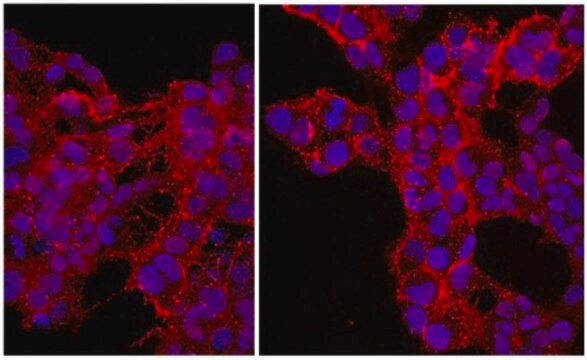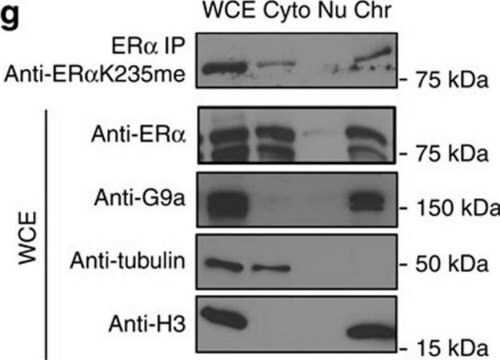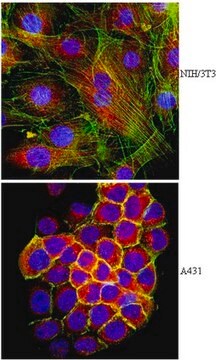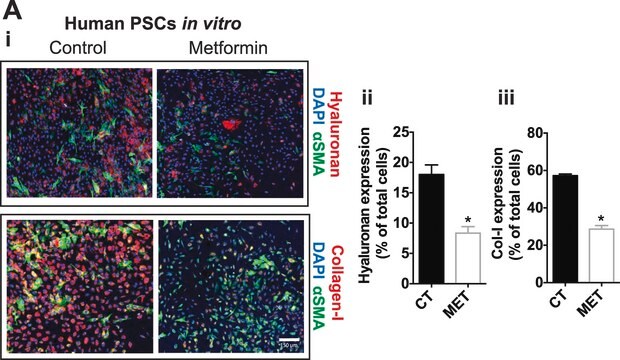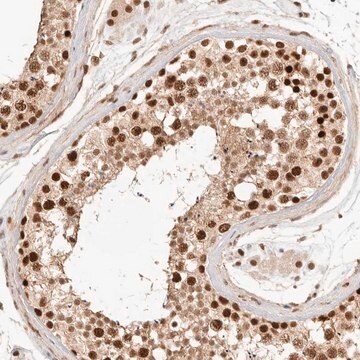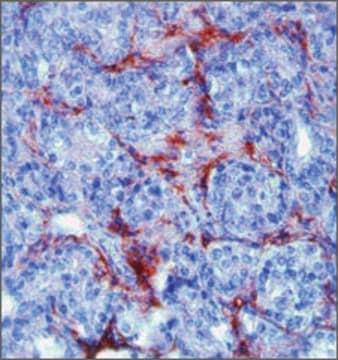추천 제품
생물학적 소스
rabbit
결합
unconjugated
항체 형태
affinity isolated antibody
항체 생산 유형
primary antibodies
클론
polyclonal
제품 라인
Prestige Antibodies® Powered by Atlas Antibodies
형태
buffered aqueous glycerol solution
종 반응성
human, mouse, rat
기술
immunoblotting: 1:100-1:250
immunohistochemistry: 1:200-1:500
면역원 서열
AGGQHLLGPPDGAKALEVAAPESQGLDSSLDGAARPKGSRRSVPRSSGQTVCRCPNCLEAERLGAPCGPDGGKKKHLH
UniProt 수납 번호
배송 상태
wet ice
저장 온도
−20°C
타겟 번역 후 변형
unmodified
유전자 정보
human ... SP6(80320)
일반 설명
SP6 (sp6 transcription factor), also called as KLF14 (kruppel-like factor 14) or Epfn (epiprofin) belongs to SP/KLF (kruppel-like factor) transcription factor family. The protein is encoded by maternally inherited intronless gene, mapped to human chromosome 17q21.3-q22.
KLF14 transcription factor is predominantly expressed in fetal tissues and placenta than in adult tissues. The encoded protein consists of three C2H2-type zinc-fingers attached to each other by kruppel-links at the end of the carboxy-terminal domain and transactivation/suppressor domain at the end of the N-terminal domain.
KLF14 transcription factor is predominantly expressed in fetal tissues and placenta than in adult tissues. The encoded protein consists of three C2H2-type zinc-fingers attached to each other by kruppel-links at the end of the carboxy-terminal domain and transactivation/suppressor domain at the end of the N-terminal domain.
면역원
Sp6 transcription factor recombinant protein epitope signature tag (PrEST)
애플리케이션
All Prestige Antibodies Powered by Atlas Antibodies are developed and validated by the Human Protein Atlas (HPA) project and as a result, are supported by the most extensive characterization in the industry.
The Human Protein Atlas project can be subdivided into three efforts: Human Tissue Atlas, Cancer Atlas, and Human Cell Atlas. The antibodies that have been generated in support of the Tissue and Cancer Atlas projects have been tested by immunohistochemistry against hundreds of normal and disease tissues and through the recent efforts of the Human Cell Atlas project, many have been characterized by immunofluorescence to map the human proteome not only at the tissue level but now at the subcellular level. These images and the collection of this vast data set can be viewed on the Human Protein Atlas (HPA) site by clicking on the Image Gallery link. We also provide Prestige Antibodies® protocols and other useful information.
The Human Protein Atlas project can be subdivided into three efforts: Human Tissue Atlas, Cancer Atlas, and Human Cell Atlas. The antibodies that have been generated in support of the Tissue and Cancer Atlas projects have been tested by immunohistochemistry against hundreds of normal and disease tissues and through the recent efforts of the Human Cell Atlas project, many have been characterized by immunofluorescence to map the human proteome not only at the tissue level but now at the subcellular level. These images and the collection of this vast data set can be viewed on the Human Protein Atlas (HPA) site by clicking on the Image Gallery link. We also provide Prestige Antibodies® protocols and other useful information.
생화학적/생리학적 작용
SP6 (sp6 transcription factor) might be involved in regulation of transcription process. In mice, SP6 or Epfn (Epiprofin) is involved in epidermal development.
TGF (transforming growth factor)-β treatment upregulates SP6 or KLF14 (Kruppel-like factor 14), which is a vital non-smad protein that potentially represses the transforming growth factor-β receptor II (TGF-βRII). SP6 aids in tooth development by regulating the epithelial cell fate and tooth number.
TGF (transforming growth factor)-β treatment upregulates SP6 or KLF14 (Kruppel-like factor 14), which is a vital non-smad protein that potentially represses the transforming growth factor-β receptor II (TGF-βRII). SP6 aids in tooth development by regulating the epithelial cell fate and tooth number.
특징 및 장점
Prestige Antibodies® are highly characterized and extensively validated antibodies with the added benefit of all available characterization data for each target being accessible via the Human Protein Atlas portal linked just below the product name at the top of this page. The uniqueness and low cross-reactivity of the Prestige Antibodies® to other proteins are due to a thorough selection of antigen regions, affinity purification, and stringent selection. Prestige antigen controls are available for every corresponding Prestige Antibody and can be found in the linkage section.
Every Prestige Antibody is tested in the following ways:
Every Prestige Antibody is tested in the following ways:
- IHC tissue array of 44 normal human tissues and 20 of the most common cancer type tissues.
- Protein array of 364 human recombinant protein fragments.
결합
Corresponding Antigen APREST75965
물리적 형태
Solution in phosphate buffered saline, pH 7.2, containing 40% glycerol and 0.02% sodium azide.
법적 정보
Prestige Antibodies is a registered trademark of Merck KGaA, Darmstadt, Germany
면책조항
Unless otherwise stated in our catalog or other company documentation accompanying the product(s), our products are intended for research use only and are not to be used for any other purpose, which includes but is not limited to, unauthorized commercial uses, in vitro diagnostic uses, ex vivo or in vivo therapeutic uses or any type of consumption or application to humans or animals.
적합한 제품을 찾을 수 없으신가요?
당사의 제품 선택기 도구.을(를) 시도해 보세요.
Storage Class Code
10 - Combustible liquids
WGK
WGK 1
Flash Point (°F)
Not applicable
Flash Point (°C)
Not applicable
시험 성적서(COA)
제품의 로트/배치 번호를 입력하여 시험 성적서(COA)을 검색하십시오. 로트 및 배치 번호는 제품 라벨에 있는 ‘로트’ 또는 ‘배치’라는 용어 뒤에서 찾을 수 있습니다.
S Scohy et al.
Genomics, 70(1), 93-101 (2000-11-23)
Using the sequence of the SP1 zinc-finger DNA-binding domain as a probe to screen a mouse EST database, we identified two novel members of the SP/XKLF transcription factor family, KLF13 and KLF14. The mouse Klf13 cDNA (1310 bp in length)
Takashi Nakamura et al.
The Journal of biological chemistry, 283(8), 4825-4833 (2007-12-25)
In tooth morphogenesis, the dental epithelium and mesenchyme interact reciprocally for growth and differentiation to form the proper number and shapes of teeth. We previously identified epiprofin (Epfn), a gene preferentially expressed in dental epithelia, differentiated ameloblasts, and certain ectodermal
C R Gonzalez et al.
Cytokine, 61(2), 670-675 (2013-01-16)
Transforming growth factor β1 (TGF-β1) is a pleiotropic cytokine that modulates cell homeostasis. In Leydig cells, TGF-β1 exerts stimulatory and inhibitory effect depending on the type I receptor involved in the signaling pathway. The aim of the present work was
Layla Parker-Katiraee et al.
PLoS genetics, 3(5), e65-e65 (2007-05-08)
Imprinted genes are expressed in a parent-of-origin manner and are located in clusters throughout the genome. Aberrations in the expression of imprinted genes on human Chromosome 7 have been suggested to play a role in the etiologies of Russell-Silver Syndrome
Takashi Nakamura et al.
Journal of cell science, 127(Pt 24), 5261-5272 (2014-10-26)
The basal layer of the epidermis contains stem cells and transit amplifying cells that rapidly proliferate and differentiate further into the upper layers of the epidermis. A number of molecules have been identified as regulators of this process, including p63
자사의 과학자팀은 생명 과학, 재료 과학, 화학 합성, 크로마토그래피, 분석 및 기타 많은 영역을 포함한 모든 과학 분야에 경험이 있습니다..
고객지원팀으로 연락바랍니다.
